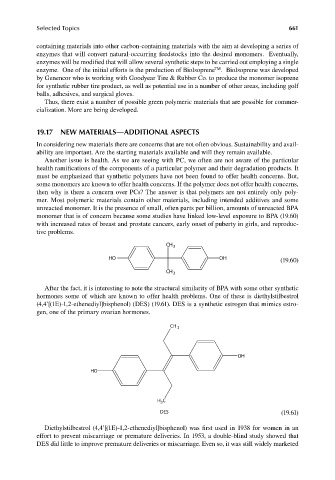Page 698 - Carrahers_Polymer_Chemistry,_Eighth_Edition
P. 698
Selected Topics 661
containing materials into other carbon-containing materials with the aim at developing a series of
enzymes that will convert natural-occurring feedstocks into the desired monomers. Eventually,
enzymes will be modified that will allow several synthetic steps to be carried out employing a single
TM
enzyme. One of the initial efforts is the production of BioIsoprene . BioIsoprene was developed
by Genencor who is working with Goodyear Tire & Rubber Co. to produce the monomer isoprene
for synthetic rubber tire product, as well as potential use in a number of other areas, including golf
balls, adhesives, and surgical gloves.
Thus, there exist a number of possible green polymeric materials that are possible for commer-
cialization. More are being developed.
19.17 NEW MATERIALS—ADDITIONAL ASPECTS
In considering new materials there are concerns that are not often obvious. Sustainability and avail-
ability are important. Are the starting materials available and will they remain available.
Another issue is health. As we are seeing with PC, we often are not aware of the particular
health ramifications of the components of a particular polymer and their degradation products. It
must be emphasized that synthetic polymers have not been found to offer health concerns. But,
some monomers are known to offer health concerns. If the polymer does not offer health concerns,
then why is there a concern over PCs? The answer is that polymers are not entirely only poly-
mer. Most polymeric materials contain other materials, including intended additives and some
unreacted monomer. It is the presence of small, often parts per billion, amounts of unreacted BPA
monomer that is of concern because some studies have linked low-level exposure to BPA (19.60)
with increased rates of breast and prostate cancers, early onset of puberty in girls, and reproduc-
tive problems.
CH 3
HO OH
(19.60)
CH 3
After the fact, it is interesting to note the structural similarity of BPA with some other synthetic
hormones some of which are known to offer health problems. One of these is diethylstilbestrol
(4,4′[(1E)-1,2-ethenediyl]bisphenol) (DES) (19.61). DES is a synthetic estrogen that mimics estro-
gen, one of the primary ovarian hormones.
CH 3
OH
HO
H C
3
DES (19.61)
Diethylstilbestrol (4,4′[(1E)-1,2-ethenediyl]bisphenol) was first used in 1938 for women in an
effort to prevent miscarriage or premature deliveries. In 1953, a double-blind study showed that
DES did little to improve premature deliveries or miscarriage. Even so, it was still widely marketed
9/14/2010 3:44:10 PM
K10478.indb 661 9/14/2010 3:44:10 PM
K10478.indb 661

